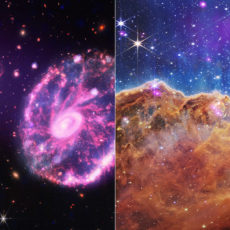
NASA’s James Webb Space Telescope successfully mapped the weather on the hot gas-giant exoplanet WASP-43 b, which is located 280 light-years from Earth. It was able to make precise brightness measurements over a broad spectrum of mid-infrared light and then combined that data with 3D climate models and previous observations from other telescopes.


What astronomers discovered was the presence of thick, high clouds covering the nightside, clear skies on the dayside, and equatorial winds upwards of 5,000 miles per hour mixing atmospheric gases around the planet. WASP-43 b is classified as a “hot Jupiter” type of exoplanet, or similar in size to Jupiter, made primarily of hydrogen and helium. Due to its tight orbit, the planet is tidally locked, meaning one side is continuously illuminated and the other in permanent darkness. The dayside was measured to have an average temperature of nearly 2,300 degrees Fahrenheit, while the nightside is significantly cooler at 1,100 degrees Fahrenheit.
- Interactive model – Inspire kids to build a representation of the Earth, Sun and Moon in orbit with this LEGO Technic Planet Earth and Moon in Orbit...
- Educational space toy – Kids can turn the crank to see how the Earth and the Moon orbit around the Sun
- Includes months and moon phases – This solar system toy includes printed details, like the month and moon phases to help kids see how the Earth’s...
With Hubble, we could clearly see that there is water vapor on the dayside. Both Hubble and Spitzer suggested there might be clouds on the nightside. But we needed more precise measurements from Webb to really begin mapping the temperature, cloud cover, winds, and more detailed atmospheric composition all the way around the planet,” said Taylor Bell, researcher from the Bay Area Environmental Research Institute.










